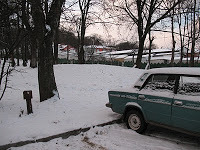Ruth Ellen Gruber's Blog, page 26
January 18, 2011
Italy -- Article on Pitigliano
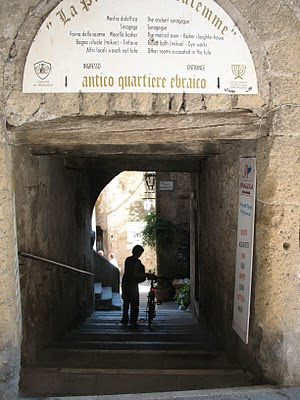 Entering the old Jewish quarter. Photo (c) Ruth Ellen Gruber
Entering the old Jewish quarter. Photo (c) Ruth Ellen GruberBy Ruth Ellen Gruber
The Vancouver Sun runs an article by Amy Stone about Pitigliano, the one-time "Little Jerusalem" in southern Tuscany -- and my choice for possibly the alltime most stunning Italian hill town (see my own article posted here a few months ago).
In the ghetto (indistinguishable today from the rest of the old city), the synagogue and its underground maze with an oven for baking matzo (unleavened Passover bread), the remains of the mikvah ritual bath, a kosher butcher, and "cantina" for pressing and storing kosher wine preserve the Jewish past. A small museum is a new addition.
An elegant and curvaceous Italian beauty, the synagogue was built in 1598 and lovingly restored in the 1990s. Its rounded wooden lectern and carved pews have been meticulously reconstructed, along with the grey-and-white marble floor. Spidery chandeliers hang from the ceiling.
Miraculously, in the 1960s, when walls of the abandoned building collapsed into the ravine, the women's gallery survived. Once again visitors can climb the stairs for the female eye view of the synagogue through the elaborately carved wooden screen.
One of only three Jews still living in Pitigliano, Elena Servi is the spirit behind what remains of Jewish life. The last matzo was baked in 1939, and the last Yom Kippur service was held 20 years later.
Published on January 18, 2011 08:55
January 12, 2011
Eastern Europe -- (Candlesticks) on Stone
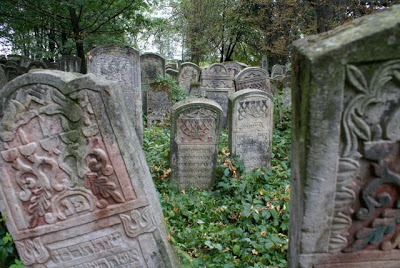 My great-great grandmother's tombstone (center) in Radauti. Photo (c) Ruth Ellen Gruber
My great-great grandmother's tombstone (center) in Radauti. Photo (c) Ruth Ellen GruberBy Ruth Ellen Gruber
I arrived at Brandeis University, near Boston, this week to take up a Scholar in Residence fellowship at the Hadassah Brandeis Insitute. For almost the next two months, I will be working on my (Candle)sticks on Stone project about the representation of women in Jewish tombstone art.
It is a multi-faceted project based on the photographic work I have carried out in the Jewish cemeteries of northern Romania, Ukraine, Poland and elsewhere, where the decorative carving on Jewish tombstones is often highly elaborate and scuptural.
I have long been fascinated by the iconography and purely decorative carving on the tombs -- my Candlesticks project focuses on the artistry and symbolism used on women's tombstones. Candlesticks often mark the graves of women, as lighting the Sabbath candles is the only one of the "three women's commandments" that can easily be represented in physical artistic form (the others have to do with observing the laws of Niddah separating men from women during their menstrual periods, and that of Challah, or burning a piece of dough when making bread.)
In addition to organizing and adding more photos to the web site, I will also be researching tombstones and symbolism -- and I will also be investigating the transmission of tradition. The main cemetery I have documented, in Radauti, Romania, is where at least two of my female ancestors are buried, each a pious woman who observed traditions and whose gravestone bears the carving of candlesticks. But, in my generation, few if any of the descendants of these women regularly light the candles.
Published on January 12, 2011 11:32
January 9, 2011
France -- Comprehensive jewish Travel Web site
By Ruth Ellen Gruber
I just caught up with an official French web site devoted to Jewish travel in France. I'm very happy to see this! It is sponsored by the office French tourism office and features the work of Toni Kamins, who wrote a groundbreaking guide to Jewish travel in France some years ago. It will feature articles, updates, travel tips and podcasts.
From Toni's introduction:

I just caught up with an official French web site devoted to Jewish travel in France. I'm very happy to see this! It is sponsored by the office French tourism office and features the work of Toni Kamins, who wrote a groundbreaking guide to Jewish travel in France some years ago. It will feature articles, updates, travel tips and podcasts.
From Toni's introduction:
France's Jewish community is the third largest in the world. Jewish history in France stretches back more than 2,000 years. Yet despite the shameful tragedies that have befallen the Jewish community, France has been and remains a center of Jewish life and shares an unshakable bond with its Jewish citizens
We know that it will take only a little effort to remind you, the Jewish traveler, that France is a destination worth visiting. Why? Because the historical and cultural ties that unite France and the Jewish people go far beyond tourism. Take a tip from Benjamin of Tudela, the 12th-century Jewish traveler whose writings bring us vivid portraits of the Jewish communities of his time. Come to France and see for yourself the dynamic and vibrant world of France's Jewish communities. Admire synagogues and monuments, enjoy the Jewish-style and kosher cuisine of Tsarfat ( the Hebrew word for France), and marvel at ancient neighborhoods in cities and towns around the country. Understand why the Jewish saying heureux comme Dieu en France (as happy as God in France) is as true today as it was in the Middle Ages.
Published on January 09, 2011 13:56
December 31, 2010
Jews, Travel, Anti-Semitism?
By Ruth Ellen Gruber
Hilary Larson, a travel writer for the New York Jewish Week, has written an article about anti-Semitism and the Jewish traveler...

Hilary Larson, a travel writer for the New York Jewish Week, has written an article about anti-Semitism and the Jewish traveler...
In Europe, I have found, ugly remarks about Israel and Jewish stereotypes surface as a matter of course, with the tacit assumption that everyone shares an anti-Israel viewpoint — and that nobody present is Jewish.She also writes:
If it is unfashionable to say ethnically pointed things in historically multicultural America, it can sometimes seem the opposite abroad, at least with regard to Jews and Israel. And it can make traveling to otherwise lovely lands, filled with otherwise friendly people, very uncomfortable for American Jews.
I've seen a lot of swastikas in my travels, and heard plenty of verbal equivalents. But I've also been surprised by the degree to which some Europeans are excited to meet a Jew (a rare specimen in some parts), or demonstrate genuine interest and enthusiasm over Jewish culture — like my German classmates in Italy who made a point of touring local synagogues.Though anti-semitism is not the focus of this blog -- I'm wondering what readers have to say on the subject.
Published on December 31, 2010 11:56
December 29, 2010
Eating Jewishly
By Ruth Ellen Gruber
A couple of months ago, Saveur magazine published a series of articles by David Sax about eating Jewishly in Budapest and Bucharest. I advised him on the piece and pointed out people to talk to in Budapest -- essentially the same people that I noted in my own article about Jewish food in Budapest for JTA.....

A couple of months ago, Saveur magazine published a series of articles by David Sax about eating Jewishly in Budapest and Bucharest. I advised him on the piece and pointed out people to talk to in Budapest -- essentially the same people that I noted in my own article about Jewish food in Budapest for JTA.....
A visit to eastern Europe reveals the origins of the cured and smoked meats, matzo balls, pickles, and other beloved staples of Jewish delicatessens around the world. "It hit me that it's nothing short of a miracle that these foods, these traditions, have survived," writes author David Sax.
Published on December 29, 2010 04:28
December 25, 2010
Ukraine --Design competition in L'viv
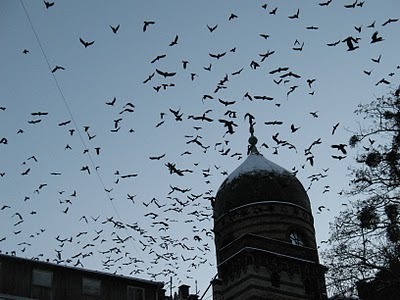 Starlings over the dome of the former Jewish hospital (now the maternity hospital) in L'viv next to the Besojlem site. Photo (c) Ruth Ellen Gruber
Starlings over the dome of the former Jewish hospital (now the maternity hospital) in L'viv next to the Besojlem site. Photo (c) Ruth Ellen GruberBy Ruth Ellen Gruber
As I noted in earlier posts, I was in L'viv, Ukraine, this past week as part of the nine-member international jury for an important design competition for sites of Jewish history in L'viv (or Lvov, Lwow, Lemberg, Leopoli, as it is called in various languages...) that was organized by the municipal authorities in association with the L'viv Center for Urban History and the German organization GTZ -- the Deutsche Gesellschaft für Technische Zusammenarbeit. The idea for the competition goes back to an international conference held at the Center for Urban History in October 2008 on "Urban Jewish Heritage and History," at which I was the keynote speaker. (I have already posted the results -- or see them HERE.)
The jury was composed of two eminent architects/urban designers from Switzerland and Germany, the L'viv deputy mayor, three local city architects/heritage experts, and three "Jewish representatives" -- myself, Josef Zissels (chairman of one of the main Ukrainian Jewish umbrella organizations) and Sergey Kravtsov, from the Center for Jewish Art in Jerusalem, who comes from L'viv and is an expert on all aspects of Jewish heritage there. (See full list below.)
Our brief was to consider some 70 designs sent in from 14 different countries for projects marking three key sites, taking into consideration the following stated criteria:
The competition has two distinct, but interconnected purposes. First, the competiton seeks to respond to the growing awareness of Lviv's multi-ethnic past by contributing to the rediscovery of the city's Jewish history and heritage through creating public spaces dedicated to the city's historic Jewish community. Secondly, the competition also seeks ways to re-design these three open public spaces in such as manner as to improve the quality of life for the contemporary inhabitants and visitors of Lviv.
Our first order of business was to visit the three sites. (We got started late as two of us -- including myself -- got stranded overnight in Vienna because of the snow chaos, and we arrived a day late.)
-- the "Valley of Death" that was linked to the infamous Janivski concentration, labor and mass murder camp set up by the German occupation during World War II, where more than 100,000 Jews were killed;
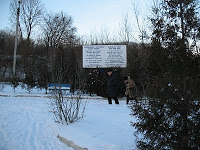
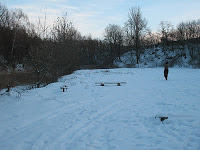
This site is a deep, rather narrow valley rimmed by steep banks.The site of the camp itself, atop a plateau overlooking the valley, is now occupied by a prison. In the valley there is a pond where bodies were thrown. For a full description, click HERE. Marking the spot is currently a memorial stone and a sign.
-- the site of three destroyed synagogues in the center of the city's downtown Jewish quarter, just off the main market square, or Rynok;
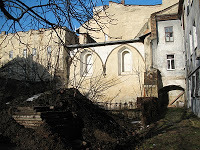 Ruins of Golden Rose synagogue
Ruins of Golden Rose synagogue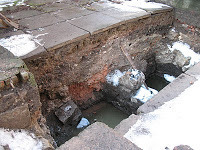 Excavations for Bejs Midrash
Excavations for Bejs MidrashThe site is an open public space located in the southeast part of Lviv's historic inner city, which is included on UNESCO's World Heritage List, on the site where once stood the Great Synagogue and a Bejt HaMidrash. They adjoin the still-visible ruins of the 16th century Turei Zahav or Golden Rose Synagogue. Some of the buildings in the immediate vicinity of the site date back to the 16th century. For fuller description click HERE. It is a sensitive area, where gentrification is beginning to clash with historic memory, preservation goals and potential Jewish restitution claims for communal property.
-- and "Besojlem," the small piece of open ground that is the only section of the centuries-old Jewish cemetery (founded in late medieval times and closed in 1855) that was not built over -- virtually all the rest of the cemetery is now covered by a big market bazaar, the Krakovsky Market. Adjacent is the city's maternity hospital, a Moorish style structure with a dome that was built originally as the Jewish hospital. It occupies a part of the cemetery site where no burials took place.
This is a particularly sensitive site, given the fact that burials still exist here but exactly where is not known. Also, it is believed that a number of old tombstones also lie beneath the surface. There is a long and contentious history regarding attempts by the Jewish community to regain the cemetery -- or at least have the market removed. Sam Gruber has posted a concise summary on his blog.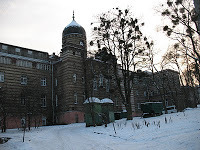
All the submitted designs were hung in the city's drafty, Soviet-era Palace of the Arts and were on public display as of December 16.
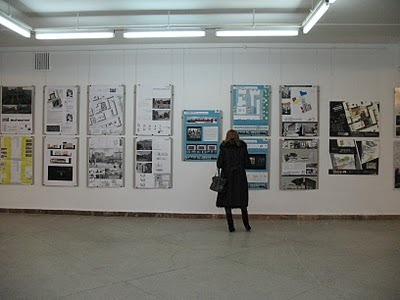 Photo (c) Ruth Ellen Gruber
Photo (c) Ruth Ellen GruberOur deliberations took place here -- in a vast hall that was freezing!
 Sofia Dyak, the director of the L'viv Center for Urban History, at our work table. Photo (c) Ruth Ellen Gruber
Sofia Dyak, the director of the L'viv Center for Urban History, at our work table. Photo (c) Ruth Ellen GruberThe jury included a varied group of experts from several countries, and we each looked at the sites and projects from different viewpoints and experience. This made our deliberations extremely intensive, thoughtful, thought-provoking, exhaustive -- and exhausting. We examined the displayed plans, as well as other information, and discussed each not just on its design, but on its feasibility of implementation and sensitivity to place. The concerns of the Jewish community were also taken into consideration, even though (aside from L'viv native but current Jerusalemite Sergey Kravstov) there was no representative of the local L'viv Jewish community on the jury. All of the submissions were anonymous, so we had no idea where they came from -- in the end, it turned out that there were submissions from 14 countries.
In addition to myself, the Jury members were:
Oksana Boyko (Ukraine, Lviv), architectural historian, research fellow at the institute "Ukrzakhdproektrestvratsia," author of the monograph "Synagogues of Lviv" (2008)
Bohdan Cherkes (Ukraine, Lviv), professor for architecture, director of the Institute of Architecture at the National Polytechnic University in Lviv
Carl Fingerhuth (Switzerland, Zürich), architect, city planner and author, advisor to the city governments of Bremen, Salzburg, Halle, Karlsruhe, Cologne, Stuttgart, Heidelberg, Regensburg; Chief Architect Basel 1979-1992, since 1995 Honorary Professor for Urban Planning at the University of Darmstadt, private projects in Switzerland, Germany, Austria, Poland, Czech Republic, Hungary and China
Vasyl Kosiv (Ukrain, Lviv), Deputy Mayor for Humanitarian Issues of Lviv, Director of the Department of Graphic Design at the National Academy of Arts in Lviv
Sergei Kravtsov (Israel, Jerusalem), architect, historian of architecture, researcher at the Center of Jewish Arts at the Hebrew University of Jerusalem
Yuriy Kryvoruchko (Ukraine, Lviv), head of the Department of Urban Planning of Lviv City Council, Chief Architect of Lviv, professor for architecture at the National Polytechnic University in Lviv
Ingo Andreas Wolf (Germany, Leipzig), architect, Urbanist, advisor to city governments; Professor for urban planning and design, University of Applied Sciences in Leipzig
Josef Zissels (Ukraine, Kyiv), Chairman of the General Council of Euro-Asian Jewish Congress, chairman of the Association of Jewish Organizations and Communities of Ukraine (Vaad Ukraine), executive vice-president of the Congress of National Communities of Ukraine and the Jewish Confederation of Ukraine
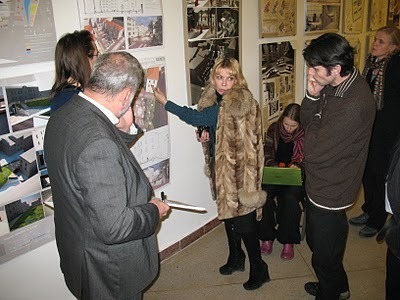 Discussing one of the designs. Photo (c) Ruth Ellen Gruber
Discussing one of the designs. Photo (c) Ruth Ellen GruberIn the end, we were were almost totally unanimous in choosing the three designs that we awarded the first prize in each category. For each of them, however, we appended recommendations as to changes or amendments we felt needed to be taken into consideration before implementation. (I'm not sure these have all be made public yet -- I will append them when so.)
The first prizes went to:
-- Ronit Lombrozo, from Jerusalem, for Besojlem. A landscape architect and exhibition designer who often deals with heritage issues, Lombrozo submitted a design that envisages a raised walkway and also the use of unearthed tombstones as part of the memorial.
-- The design team of Ming-Yu Ho, Ceanatha La Grange, and Wei Huang, from Irvine, California, for the Janivski concentration camp site. Their design was radically different from most of the others. Most of the others envisaged the area as a sort of park. The winning team's idea was to turn it into a form of land art -- a raised walkway leading to and curving around a slope covered with slabs representing symbolic tombstones.
-- The Berlin, Germany team of Franz Reschke, Paul Reschke and Frederik Springer for the synagogue square site, a design that incorporates the archeological excavations of the Bejs Midrash and also traces the form of the Great Synagogue. One of the things that we liked is that it leaves the way open for modifications in the future, should the site be restituted or other excavations be foreseen.
Other prizes and honorable mentions went to designs from Italy, Poland, Germany, Austria and Ukraine.
I was particularly pleased to see how young the Ukrainian winners were -- some in their early and mid-20s, even students -- and to witness how thoughtful and sensitive their approaches were to reintegrating and restoring a component of local history that has for far too long been suppressed, ignored, forgotten and/or distorted.
 L'viv deputy mayor Vasyl Kosiv announces the awards at a public ceremony. Photo (c) Ruth Ellen Gruber
L'viv deputy mayor Vasyl Kosiv announces the awards at a public ceremony. Photo (c) Ruth Ellen Gruber
Published on December 25, 2010 04:26
Ukraine -- Jewish heritage initiatives
By Ruth Ellen Gruber
JTA last week ran a nice story by Dina Kraft about an initiative to document and rescue Jewish heritage sites in western Ukraine, with the help of local Ukrainians. One of the Israeli experts is Vladimir Levin, whom I met last year in Vilnius, when we both took part in a seminar organized by the Lithuanian Culture Ministry about how to deal with Jewish heritage in Lithuania.

JTA last week ran a nice story by Dina Kraft about an initiative to document and rescue Jewish heritage sites in western Ukraine, with the help of local Ukrainians. One of the Israeli experts is Vladimir Levin, whom I met last year in Vilnius, when we both took part in a seminar organized by the Lithuanian Culture Ministry about how to deal with Jewish heritage in Lithuania.
Levin, a 39-year-old immigrant to Israel from St. Petersburg, Russia, is part of a team of Israeli historians attempting to document what remains of a once populous and vibrant Jewish life in the regions of Galicia and Bukovina, most of which is in the western edge of present-day Ukraine.
As part of efforts to recover the world that once was in these towns and shtetls, where some 1 million Jews lived before the Holocaust, the researchers are partnering with Ukrainian academics. The idea is not only to boost the level of scholarship but to highlight to Ukrainian locals a Jewish past that spanned centuries but is rarely remembered publicly in the country.
"Jewish history is not part of the agenda" in Ukraine, said Yaroslav Hrystak, director of graduate studies at the Ukrainian Catholic University, which has partnered with the Israeli researchers. "It's like a whole subject that disappeared."
The project aims to collect oral testimony and document cemeteries and synagogues left derelict or used for such purposes as canning factories to storage space, and enlist young Ukrainian historians to do Jewish-related scholarship. An online database has been established on the project's website to make the research widely accessible. The project also has set up a scholarship for Ukrainian graduate students to spend a year at Hebrew University to learn Jewish history, Hebrew and Yiddish.
"Records are being lost in front of us, and so the goal is collection and preservation," said David Wallach, a professor of molecular biology at Israel's Weizmann Institute who is among the group of families that helped establish a fund called the Ludmer Project to help pay for the research.
Published on December 25, 2010 02:07
December 24, 2010
Virtually Jewish in Japan: Fiddler on the Roof
By Ruth Ellen Gruber
Before I think deeply and prepare some reflections on my five days in L'viv as part of the international jury for the city's design competition to mark three key sites of Jewish history, I just have to post this -- "If I Were a Rich man", from a Japanese production of Fiddler on the Roof in 1982; a priceless example of Jewish virtuality:

Before I think deeply and prepare some reflections on my five days in L'viv as part of the international jury for the city's design competition to mark three key sites of Jewish history, I just have to post this -- "If I Were a Rich man", from a Japanese production of Fiddler on the Roof in 1982; a priceless example of Jewish virtuality:
Published on December 24, 2010 10:04
December 22, 2010
Ukraine -- results of Lviv design competition for sites of Jewish history
International Design Competition to Mark Sites of Jewish History in Lviv Results
December 22, 2010
We are pleased to announce the results of the three competitions and the winning projects.
Synagogue Square Site
1st Prize
012050
Dipl. Ing. Landscape Architect Franz Reschke Frederik Springer, Paul Reschke, Berlin, Germany
2nd Prize
012023
Yuri Stolarov, Paul Mokrel, Roman Belbas, Olha Malynovska Lviv, Ukraine
3rd Prize
012049
Unknown
Honourable Mention
012037
Moomoo Architects Jakub Majewski, Łukasz Pastuszka, Tomasz Bierzanowski, Bartołomiej Skowronek, Miriam Otero, Martyna Szymańska, Monika Komendacka, Zhenze Huang Lódź, Poland
Honourable Mention
012034
Markian Kossak Lviv, Ukraine
Honourable Mention
012021
Żaklina Nowodworska, Michal Podgórczyk Gdynia, Poland
Competition "Besojlem Memorial Park"
1st Prize
012035
Ronit Lamrozo Jerusalem, Israel
2nd Prize not awarded
3rd Prizes
012064
Michelangelo Acciaro, Nora Lau Milano, Italy
3rd Prize
012041
Danylo Shvets Andriy Zinkevych Stepan Glukhovetsky Lviv, Ukraine
3rd Prize
012007 Gerhard Rennhofer Gerhard Hauser Vienna, Austria
Competition "Yanivsky Camp Memorial Site"
1st Prize
012056
Ming-Yu Ho, Ceanatha la Grange, Wei Huang Irvine, California USA
2nd Prize
012005
Carmela Canzonieri Emanuele Cassibba Luigi Vella Aggius Benjamino Faliti Giovanna La Rosa Vittoria, Italy
3rd Prize
012068
Stefan Jan Cichosz Berlin, Germany
Honourable Mention
012030
FDKV Fedchena Nazar Lviv, Ukraine
Honourable Mention
012024
Yuri Stolarov, Paul Morkel, Roman Belbas Lviv, Ukraine
Countries: Ukraine, Poland, Italy, Germany, Austria, USA, Israel
December 22, 2010
We are pleased to announce the results of the three competitions and the winning projects.
Synagogue Square Site
1st Prize
012050
Dipl. Ing. Landscape Architect Franz Reschke Frederik Springer, Paul Reschke, Berlin, Germany
2nd Prize
012023
Yuri Stolarov, Paul Mokrel, Roman Belbas, Olha Malynovska Lviv, Ukraine
3rd Prize
012049
Unknown
Honourable Mention
012037
Moomoo Architects Jakub Majewski, Łukasz Pastuszka, Tomasz Bierzanowski, Bartołomiej Skowronek, Miriam Otero, Martyna Szymańska, Monika Komendacka, Zhenze Huang Lódź, Poland
Honourable Mention
012034
Markian Kossak Lviv, Ukraine
Honourable Mention
012021
Żaklina Nowodworska, Michal Podgórczyk Gdynia, Poland
Competition "Besojlem Memorial Park"
1st Prize
012035
Ronit Lamrozo Jerusalem, Israel
2nd Prize not awarded
3rd Prizes
012064
Michelangelo Acciaro, Nora Lau Milano, Italy
3rd Prize
012041
Danylo Shvets Andriy Zinkevych Stepan Glukhovetsky Lviv, Ukraine
3rd Prize
012007 Gerhard Rennhofer Gerhard Hauser Vienna, Austria
Competition "Yanivsky Camp Memorial Site"
1st Prize
012056
Ming-Yu Ho, Ceanatha la Grange, Wei Huang Irvine, California USA
2nd Prize
012005
Carmela Canzonieri Emanuele Cassibba Luigi Vella Aggius Benjamino Faliti Giovanna La Rosa Vittoria, Italy
3rd Prize
012068
Stefan Jan Cichosz Berlin, Germany
Honourable Mention
012030
FDKV Fedchena Nazar Lviv, Ukraine
Honourable Mention
012024
Yuri Stolarov, Paul Morkel, Roman Belbas Lviv, Ukraine
Countries: Ukraine, Poland, Italy, Germany, Austria, USA, Israel
Published on December 22, 2010 14:25
December 8, 2010
Lithuania -- promo video for Vilnius Jewish Library
By Ruth Ellen Gruber
Wyman Brent is a non-Jew from San Diego who has been working to create a Jewish library in Vilnius, Lithuania. It is now scheduled to open next year. Part of the "virtually Jewish" experience -- he now has a promotional video for the endeavor. It's a bit long, but it gives interesting insight into the virtually Jewish appeal, as well as the appeal and perception of Jewish culture and art.

Wyman Brent is a non-Jew from San Diego who has been working to create a Jewish library in Vilnius, Lithuania. It is now scheduled to open next year. Part of the "virtually Jewish" experience -- he now has a promotional video for the endeavor. It's a bit long, but it gives interesting insight into the virtually Jewish appeal, as well as the appeal and perception of Jewish culture and art.
Published on December 08, 2010 23:56

